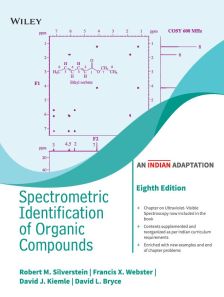Spectrometric Identification of Organic Compounds, 8ed (An Indian Adaptation)
ISBN: 9789354642296
For more information write to us at: acadmktg@wiley.com

Description
The Indian Adaptation of Spectrometric Identification of Organic Compounds, eighth edition of the book is reorganized, enhanced, and updated to offer complete coverage of Indian curriculum. Almost all spectroscopic techniques include updates in theory, instrumentation, and characterization of group absorptions UV-Visible Spectroscopy is now included as a part of the book. Chapter on Two-Dimensional NMR Spectroscopy is reorganized to explain 2D NMR techniques first with examples of simple molecules and then applied to analyze more complex molecules.
Preface to the Adapted Edition
Preface to Eighth Edition
Preface to First Edition
Chapter 1 Ultraviolet-Visible Spectroscopy
1.1 Introduction
1.2 Theory
1.3 Instrumentation
1.4 Characteristic Absorption of Organic Compounds
Chapter 2 Mass Spectrometry
2.1 Introduction
2.2 Instrumentation
2.3 Ionization Methods
2.4 Mass Analyzers
2.5 Interpretation of EI Mass Spectra
2.6 Mass Spectra of Some Chemical Classes
2.7 Other Applications of Mass Spectrometry
Chapter 3 Infrared Spectroscopy
3.1 Introduction
3.2 Theory
3.3 Instrumentation
3.4 Sample Handling
3.5 Interpretation of Spectra
3.6 Characteristic Group Absorptions of Organic Molecules
Chapter 4 Proton (1H) Magnetic Resonance Spectroscopy
4.4 Chemical Shift
4.5 Spin–spin Coupling, Multiplets, and Spin Systems
4.6 Protons on Oxygen, Nitrogen, and Sulfur Atoms: Exchangeable Protons
4.7 Coupling of Protons to Other Important Nuclei (19F, D (2H), 31P, 29Si, and 13C)
4.8 Chemical Equivalence
4.9 Magnetic Equivalence
4.10 AMX, ABX, and ABC Rigid Systems with Three Coupling Constants
4.11 Weakly and Strongly Coupled Systems: Virtual Coupling
4.12 Chirality
4.13 Magnitude of Vicinal and Geminal Coupling Constants
4.14 Long-range Coupling
4.15 Simplification of Complex NMR Spectra
4.16 Nuclear Overhauser Effect
4.17 Solid-State NMR
4.18 Conclusion
Chapter 5 Carbon-13 NMR Spectroscopy*
5.1 Introduction
5.2 Theory
5.3 Interpretation of a Simple 13C NMR Spectrum: Diethyl Phthalate
5.4 Quantitative 13C Analysis
5.5 Chemical Equivalence
5.6 Dept
5.7 Chemical Classes and Chemical Shifts
Chapter 6 Two-dimensional NMR Spectroscopy
6.1 Introduction
6.2 Theory
6.3 Homonuclear Correlation Techniques
6.4 Heteronuclear Correlation Techniques
6.5 Ipsenol
6.6 Caryophyllene Oxide
6.7 Lactose
6.8 VGSE
Chapter 7 Multinuclear Magnetic Resonance Spectroscopy
7.1 Introduction and General Considerations
7.2 15N Nuclear Magnetic Resonance
7.3 19F Nuclear Magnetic Resonance
7.4 29Si Nuclear Magnetic Resonance
7.5 31P Nuclear Magnetic Resonance
7.6 Conclusions
Chapter 8 Solved Problems
8.1 Introduction
8.2 Solved Problems
Chapter 9 Assigned Problems
9.1 Introduction
9.2 Structure Elucidation of Simple Molecules Using IR/MS/1H NMR and 13C/DEPT Spectral Data
9.3 Structure Elucidation of Molecules Using I/MS/ 1H NMR and 13C/DEPT Spectra
9.4 Structure Elucidation of Molecules Using IR/MS/ 1H NMR and 13C/DEPT and 2D NMR
9.5 Additional Spectra and Exercises
References
Index

